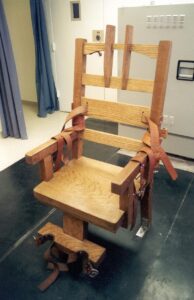
Dr. Alfred Southwick received the idea for electrocution after he had witnessed an inebriated man die from touching an electric generator. Southwick noticed that the man died instantly and without pain. He found this to be in sharp contrast to the existing methods of executing a person, such as a hanging.
Electric Chair
After studying the effects of electricity on the human body, Southwick conceived the idea of a chair able to send a powerful electrical current through a prisoner condemned to death. He took his idea to the Governor of New York, David Hill, and proposed the concept of an electric chair as an effective and more humanitarian method for capital punishment.
A man named Harold Brown who worked for master inventor Thomas Edison built the original electric chair based on Southwick’s design. He completed the first working model in 1888, and demonstrations were performed on live animals to prove how well it worked. Brown’s chair was fast and efficient, and the authorities accepted the electric chair as a method of execution.
In 1890, William Kemmler suffered the first electrocution execution after he murdered his wife with a hatchet. On August 6th, Kemmler sat down in the chair. The executioner threw the switch to start the machine, and an electric current tore through Kemmler’s body. It left him unconscious but still alive. A second jolt of electricity was needed to finish the job after the chair had been recharged, and this time Kemmler’s body began to bleed and caught on fire. Spectators referred to the 8-minute-long process as a gruesome event that was far worse than a hanging.
The concept behind the electric chair calls for a prisoner to have their arms and legs strapped in securely. Damp sponges are placed on the condemned’s head and legs, and electrodes are attached to the sponges. After the prisoner’s head is covered, the executioner throws a switch to release a sharp blast of electrical current through the chair and into the electrodes. The sponges help to conduct the electricity and bring about a swift death.
By 1899, the design of the electric chair had improved, and death by electrocution became the most common form of capital punishment in America until the 1980s, when lethal injection became the preferred method in most states.
For more information, please visit:
Execution Methods
First Execution by Electric Chair
